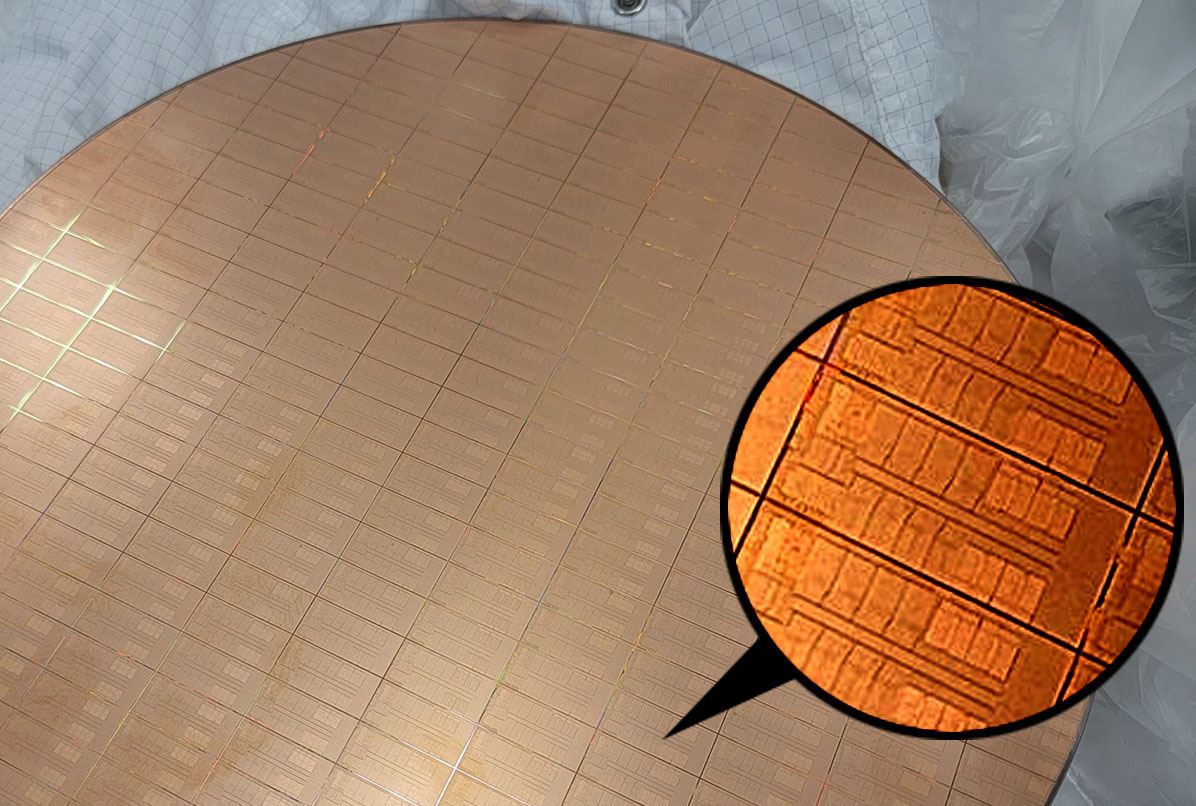Raptor Lake Wafer Pictured During Intel Tech Tour Israel Event
Wafer details such as the new P-Cores can clearly be seen.
An image of an Intel Raptor Lake filled wafer has been pictured at the Intel Tech Tour Israel event. The 12-inch wafer picture was shared by Tom’s Hardware Editor Paul Alcorn via Twitter. We opened it up on our state of the art PC and shouted ‘enhance’ at the screen to create the image below.
If you pixel peep the enhanced section it is pretty easy to see the eight Performance Cores (P-Cores) on the highlighted rectangular die. It isn’t quite as easy to see that there are also 16 Efficiency Cores (E-cores) present (but there are). So, yes, this is a Raptor-Lake-S die which could be purposed to create an Intel Core i9-13900 tier CPU, as long as it makes the grade.
We don’t need to reach for our pixel rulers and use relative scale calculations to provide an estimate of the die size. Previous info, as collected within our Raptor Lake all-we-know article, has already established that the die measures 23.8 x 10.8mm, for an area of 257mm ^2. This is nearly 25% bigger than the Intel Core i9-12900K Alder Lake die size. Both 12th and 13th Gen Intel Core processors are built on the Intel 7 process, formerly known as 10 nm Enhanced SuperFin.
|
Die Area |
Die Dimensions |
Cores |
Process | |
|---|---|---|---|---|
|
Raptor Lake Core i9-13900K |
257 mm^2 |
23.8 x 10.8 mm |
8 P-Cores | 16 E-Cores |
Intel 7 |
|
Alder Lake Core i9-12900K |
208 mm^2 |
20.4 x 10.2 mm |
8 P-Cores | 8 E-Cores |
Intel 7 |
|
Rocket Lake Core i9-11900K |
281 mm^2 |
24 x 11.7 mm |
8 P-Cores |
14nm |
|
Comet Lake Core i9-10900K |
206 mm^2 |
9.2 x 22.4 mm |
10 P-Cores |
14nm |
From the above you can see that the Raptor Lake die is significantly larger than Alder Lake, which is surprising given how Intel has admitted that Raptor Lake was a filler, created because Intel knew Meteor Lake would take longer than planned. So, the CPU configuration of Raptor Lake is different from its predecessor but things such as the iGPU and I/O die are basically unchanged. The extra die space must therefore be accounted for by (possibly) larger P-cores, the extra E-cores, the bigger caches, and other things we will find out about at the big launch event.
Click 'See More' to see full Tweet.
He's a wafer full of Raptor Lake dies. pic.twitter.com/dl2ClXz6ygSeptember 14, 2022
Intel’s Raptor Lake will be the generation which is the last of the Core series it makes as a monolithic die. One of the big leaps taken with Intel 14th Gen Core ‘Meteor Lake’ processors is going to be the change to chiplets, with a mix of semiconductor products manufactured by both Intel and TSMC under its IHS.
For more information about Raptor Lake, which is due for launch sometime next month, please check out our extensive Intel 13th-Gen Raptor Lake Specs, Rumored Release Date, Benchmarks, and More feature.
Get Tom's Hardware's best news and in-depth reviews, straight to your inbox.

Mark Tyson is a news editor at Tom's Hardware. He enjoys covering the full breadth of PC tech; from business and semiconductor design to products approaching the edge of reason.
-
Johnpombrio I was just going to say "Where are the chiplets?" Funny that my spell checker didn't know the word chiplet.Reply
